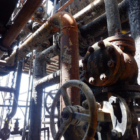The capacity to precisely evaluate the state of vital infrastructure and act quickly to resolve possible problems is crucial when it comes to asset integrity management. TechCorr is in the forefront of using cutting-edge technologies and processes to ensure the safety, dependability, and lifespan of complex industrial systems. A recent case study demonstrates the revolutionary effect of TechCorr’s proficiency in identifying and fixing major problems with a gasoil pipe system.
The Challenge: The system under consideration, designated as SK-014, is a Class 2 insulated piping network that functions within the harsh conditions of a refinery. TechCorr was tasked with performing an extensive API 570 compliance check once the system was taken offline in order to evaluate its state and find any possible threats to its integrity.
Our multidisciplinary approach to the examination included a variety of cutting-edge nondestructive testing (NDT) techniques, each of which was carefully chosen to offer insightful information about the system’s condition. At the core of our assessment was the use of Ultrasonic Thickness (UT) Measurement, which allowed us to quantify the extent of wall loss at 29 strategically chosen Condition Monitoring Locations (CMLs). The technique yielded data on mild wall thinning as well as a crucial baseline for calculating corrosion rates and estimating remaining life in the future.
TechCorr performed Positive Material Identification (PMI) at key sites, such as the suction and discharge points of pumps P-6 and P-6A, to make that the system’s material composition complied with stipulated specifications. As a critical component of preserving asset integrity, our confirmation of the 1 1/4Cr steel composition showed our dedication to precise and comprehensive material verification.

Our assessment relied heavily on visual inspections, with special attention paid to spotting indications of mechanical deterioration, coating failures, and corrosion beneath insulation (CUI). Our skilled specialists carefully inspected the system, noting any places where operating wear and environmental conditions had affected it. This thorough visual evaluation, along with the information gathered using cutting-edge NDT techniques, gave a full picture of the state of the system.

The inspection revealed various critical issues that needed immediate attention. Active surface corrosion and pitting occurred as a result of insulating seal failure, which allowed moisture ingress and subsequent corrosion to occur at depths of 0.040″ to 0.080″. The covering of the system was severely deteriorated, impairing its protective ability and aggravating the underlying corrosion problems. Furthermore, there were indications of mechanical wear and corrosion on a number of structural parts, including pipe supports and flange assemblies.
Equipped with an abundance of information obtained from the inspection, TechCorr created a thorough maintenance plan to tackle the problems found early on. Our suggestions were intended to improve the system’s long-term dependability and performance in addition to addressing the immediate issues. Every suggestion, which included replacing valves and flange assemblies, applying sophisticated coating systems, installing non-metallic wear pads at support contact areas, and more, was thoughtfully designed to maximize the integrity of the system.
This case study highlights TechCorr’s proactive approach to asset integrity management and our steadfast dedication to use the most recent NDT technology along with industry best practices to provide our clients with unmatched value. Through precise assessment of essential infrastructure and efficient restoration tactics, we empower asset owners to prolong system lifespan, guarantee adherence to safety regulations, and reduce unplanned downtime risks.




